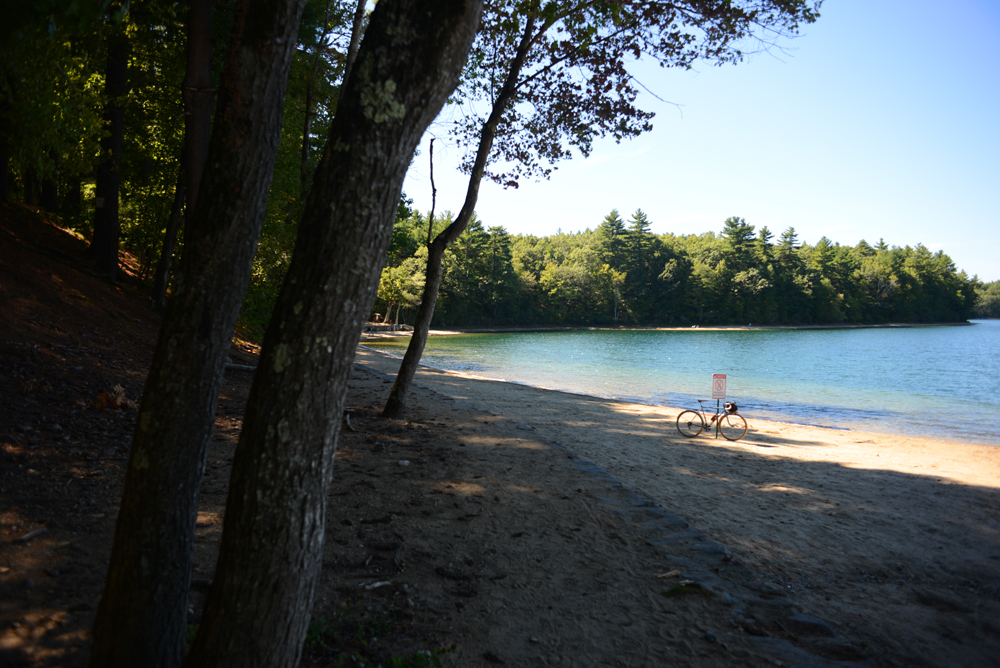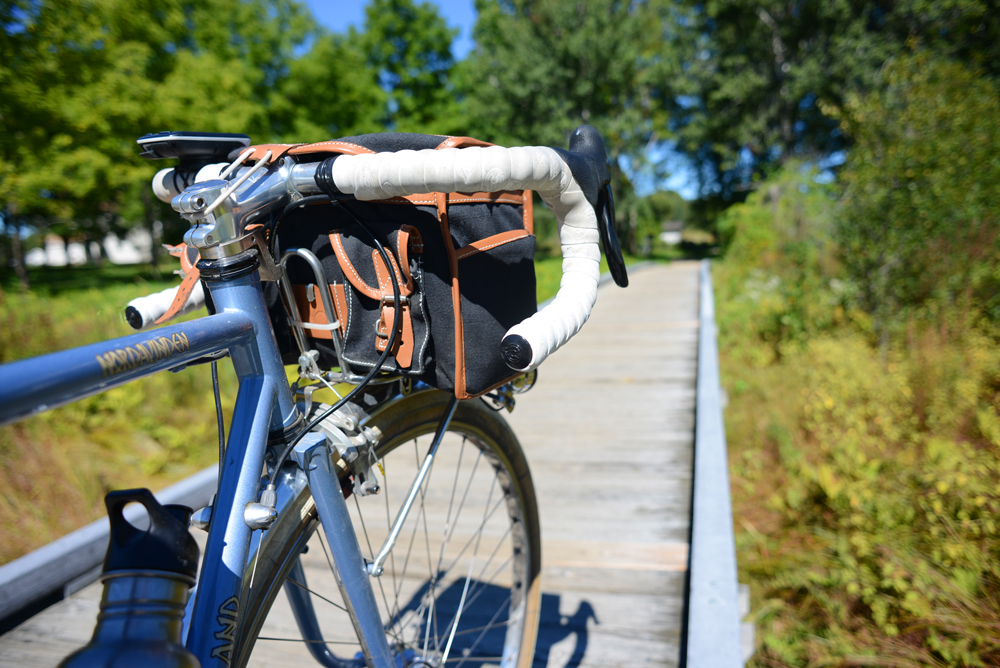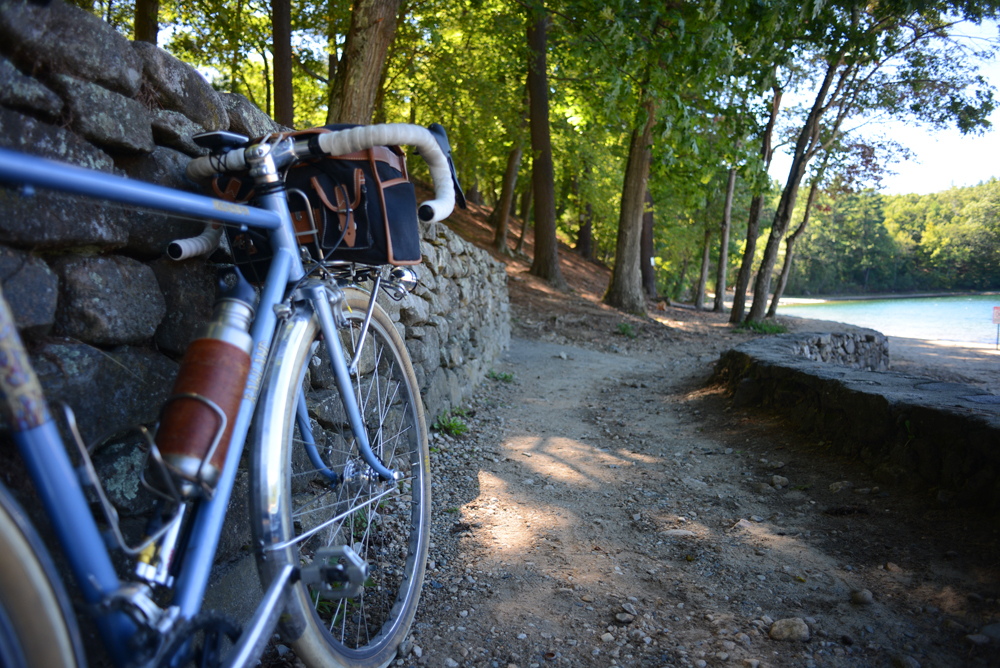Machine Memory

In the corner of the dusty storage room the bike slumped against the wall, front wheel and fender beside it. As I knelt to attach them, I tried to remember where it was that I'd taken the bicycle last time I rode it. Whose car was it? Where did we go? I was drawing a blank. As if searching for clues, I rummaged in the handlebar bag, but it had been cleaned out with an unusual, for me, meticulousness. Empty. Then I stuck my hand in the one pocket where I hadn't yet looked and fished out four neatly folded bills: a ten, a five, and two ones. Was this discovery a surprise, or did I know the cash was there all along, looking for it without realising it? I was about to pocket the money, when a strange feeling of guilt crept over me… as if I was stealing from the bike. I placed it back in the bag and then, mentally rolling my eyes at myself, dragged the bike outside into the morning sunlight. In that dark room, I had allowed myself to feel haunted by its presence. But after all, it is only a bicycle. A machine.

In the dry leaf-scented, early Autumn heat I rode and rode through once-familiar roads, up and down once-familiar hills. There were times when the bike seemed to know the way better than I did. I would approach an intersection, uncertain of how to continue, when the bike would, ever so subtly, pull to the right, or the left, and this would always be the correct way. My own route memory lagged slightly behind, synchronising with the bike's only after we'd make the turn.

On the dirt road, I relaxed on a descent through loose sand. I rolled blithely along the narrow zig-zagging boardwalks that cross the swamps. I had all but forgotten how to do this kind of riding. But my view from the saddle - the view of the dirty handlebars, sun-faded bag, and bit of fat cream tire peaking out - brought it all back. Riding here, the bike clicked into place, and the boardwalk and sand clicked into place, as if they were meant to go together - pieces in a visuo-tactile jigsaw puzzle.

When I stopped for food, I reached again for the money. It felt right this time, as if the bicycle was treating me to lunch on this ride. That was what that money was meant for, and only that. But now, crumpled underneath the folded bills, I felt something else jammed at the bottom of the pocket, and pulled it out. It was a half-discinegrated piece of paper with faded text. On closer inspection I saw it was a piece of an old route sheet. And, studying it closer still, I saw it was the route of the 300K brevet I'd abandoned. Strangely, this made me smile. And then, for reasons unknown, instead of throwing it in the waste bin I was standing next to, I crumpled it back up and pressed it into the bottom of the pocket where I'd found it.

Bicycles are only things. But what kind of things are they? They are inanimate objects that we, humans, animate and keep synchronised with our own rhythms and motions. Bicycles do not have experiences. But experiences are imprinted upon them through use. With every mile of rough road they roll through and with every drop of corrosive sweat that falls upon them, the machines come to reflect their environments and their owners. They store and activate memories.
I had bought this bike with intent to resell it once it had served its purpose. But when the time came, I ran into a mental and emotional barrier. I stalled and changed my mind half a dozen times. The bike felt too personal, and that made it unsellable. It was only after this ride that I finally felt it was time. It was time to gently, but swiftly, kill it - to give the frame I'd built for myself a chance to live, just as I had planned to in the first place, by moving over the components. And this bike? Stripped of its holistic bikeyness, it will lose its identity - and hopefully find another, replete with new machine memories.

Why had the bike slumped? Are you saying it had a serious decrease in value? And maybe the components were wagging their dusty tails in anticipation of connecting with a new friend?
ReplyDeleteYou'd slump too without your front wheel :(
DeleteNah, that's hardly a slump when it's supporting itself with those beautiful and forks, it's rump and tail up in the air eagerly awaiting your return….Now if the stem and handlebars were removed and limply hanging by the cables, that would be a dejected slump. Oh, and I lost my front wheel long ago…I'm a unicycle. ;)
DeleteGlad for your link to the birthing of the bike that will inherit the transferred components. These posts about heartache for bicycles and cycling are touching and sweet and why your blog is so rewarding to its readers! Thank you! Jim Duncan
ReplyDelete"Served it's purpose"
ReplyDeleteSuch ruthless romanticism
oh how sad and bittersweet. I'd find it hard to go through all that stuff. I'm already doing it a bit with bike parts and frames, but am having trouble selling stuff which makes it worse. With parts and frames there is often intention, dreams, and plans that never materialized. The failures do not make me feel good, the passing of time, and continued lack of 'bike luck' weighs heavy. At least you've got a great platform to sell your bikes, frames and parts. Also local friends and community will help you sell them.
ReplyDeleteRelying on ebay or craigslist is disheartening!
Good luck with the clearing and lighten your heart.
I always try to trade rather than sell; better deal for everyone and somehow less sad.
DeleteThe machine memory you so evocatively postulate is embedded in all neuromotor systems. When the field of artificial intelligence was very young, researchers tried to replicate things such as walking with fully encoded and centrally processed instuctions, and failed. It was just too complex. Later researchers realised that complex, coordinated movement is controlled through the interaction of (largely distributed) neuronal function and the kinematics of the limbs themselves. The latter act as an analog computer, solving part of the control and stability problem.
ReplyDeleteFunny how that all works. Beausage is not just the wear we give our bicycles (or any other favored, well-loved thing) but the wear they incur through their many lives as they pass through ours.
ReplyDeleteThey in turn mark us.
I dare say that the reason Celeste is beloved here is because she was beloved there.
You won't be killing the Nordavinden. It's more like an animal that molts.
It's time. No guilt.
That frame will probably build up into somebody's dream bike.
This summer I too let go of an old friend, a fillet-brazed Ritchey mountain bike I'd purchased new in 1983, complete with Shimano's first Deore mountain bike component group. Over the years it morphed into a wonderful commuter/touring bike, complete with Mavic hubs (and a screw-on freewheel), King headset, Suntour XC-Pro GreaseGuard pedals, CNC machined chainrings, and a wonderfully broken-in Brooks B17 Special saddle.
ReplyDeleteIn 1996, the year I turned 50, the Ritchey and I toured New Zealand for two months, creating indelible memories. The bike never let me down.
As years passed and other bikes, lighter, a bit faster, but not much more modern, replaced it, and it sat mostly unridden in my garage.
Several months ago, a good friend inquired...would I be willing to part with it? He'd admired it from afar for several years. It was like parting with a child, but yes! I said I'd sell to him, a worthy new owner. And he loves it as I once did. Good memories...a good parting.
I've often wondered what will happen to your wonderful two-wheeled fleet after your move. Will any more of them make the journey to Northern Ireland beside the Seven and the Brompton?
ReplyDeleteI don't actually have that many anymore. The frame I built at ANT, plus the parts from the Rawland, is getting smuggled over next.
Deletelooks to be a sweet bike!
Deletethe machine has no memory. it's you.
ReplyDeleteEvery once in a great while, though, you come across a bicycle that's something more than just an inanimate machine. Something sings when you ride it. And when a bike like that comes into your hands, you should hold onto it...
ReplyDeleteSad and beautiful at the same time. Nicely written. Enjoy your ride.
ReplyDeleteAny plans to "kill" your Seven for parts? I maybe interested in the frame!
ReplyDeleteNo : )
DeleteLovely post Velouria - we can have a special rapport with inanimate objects - to the extent we don't think of them as such.
ReplyDeleteLovely writing, thank you.
ReplyDeletei often feel that slight twinge when parting with a bike I've put many miles/hours on and have had for awhile.
ReplyDeleteWhen riding, today, it was clear I found a particular connection to my my bike and the path. The bike had no memory, it was just well designed and put together to allow me to have some good memories.
ReplyDeleteWhen you sell this bike, I certainly hope you mention that it "pulls to the right or the left"!
ReplyDeleteJoking! What a beautiful machine, if only it were in my size.
I like to think that selling, or giving away(always better), a bike is a form of paying it forward. Always a bit of sentiment involved(farewell old friend). I've always taken the attitude that if you take care of it, it will take care of you. And they do. The greatest invention ever. Dang, getting all emotional here. Better go for a ride. Peace.
ReplyDeleteKen